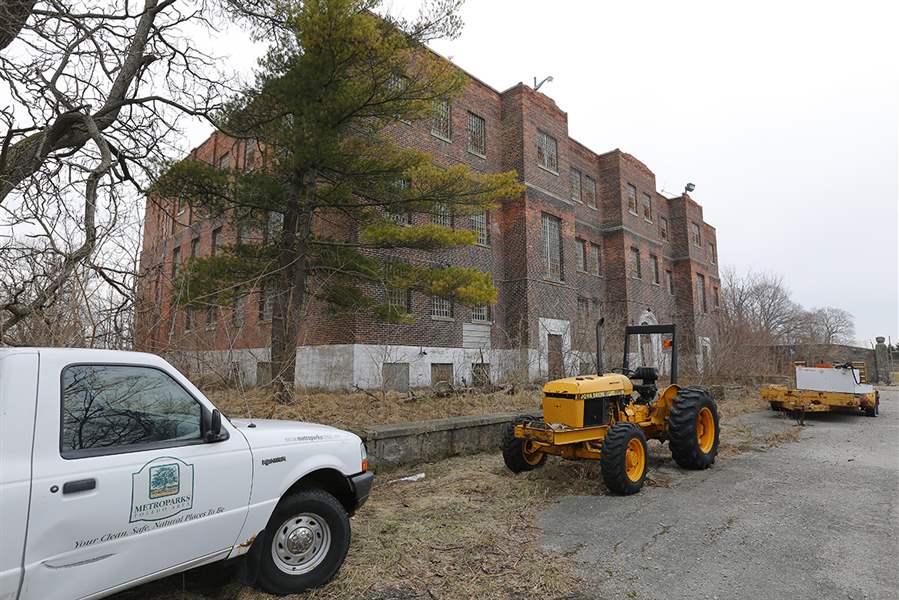
House of Correction vacated in 1991
Toledo Metroparks seeks bids for razing workhouse
4/3/2014
Metroparks of the Toledo Area owns the former Toledo House of Correction that from 1918 to 1991 housed inmates found guilty of misdemeanors. The building near Whitehouse is a well-known site.
THE BLADE/ANDY MORRISON
Buy This Image

Metroparks of the Toledo Area owns the former Toledo House of Correction that from 1918 to 1991 housed inmates found guilty of misdemeanors. The building near Whitehouse is a well-known site.
A building that housed prisoners at the Toledo House of Correction near Whitehouse is to be demolished in the coming months as part of the Metroparks of the Toledo Area’s plans to develop the Blue Creek Conservation Area.
Bids will be sought this month to demolish the three-story structure, with work to begin in July or August.
The Toledo House of Correction operated from 1918 until 1991 and housed people serving sentences for misdemeanor crimes. The inmates grew vegetables, raised hogs and cattle, and quarried limestone on the farm.
Commonly called the workhouse, some neighbors call it an eyesore.
PHOTO GALLERY: Former Toledo House of Correction near Whitehouse
Some people might be interested in trying to save the old building, such as to transform it into an antique shop, but the daughter of a former workhouse guard commented that that wouldn’t be appealing to many.
“Who has fond memories of that place?” asked Susan Bechtel, who lives near Whitehouse.
Her late father, Art Romaker, was a guard there for 10 to 15 years, Mrs. Bechtel recalled Wednesday afternoon when told about plans to demolish it.
The workhouse was popular with some prisoners who would, as stories go, commit crimes at times carefully chosen to match the season.

“They would commit a crime so they could winter over in the workhouse,” Mrs. Bechtel recalled. The House of Correction didn’t house killers, she said, but rather people found guilty of being drunk and disorderly, maybe those late on child-support payments — “low-level crimes” she said.
Teens have been known to spin tales of ghosts, jangling handcuffs or chains, wandering about and walking through thick cell walls. More than one area resident has scrambled to take a peek inside the place, either on a dare or on a mission to capture workhouse ghosts on video.
Several other buildings on the Workhouse property will remain. They include a large white barn and a smaller, stone hog barn. A building that once housed a gymnasium and dormitories is now the base of operations for the Metroparks native-seed nursery and other land management operations, said Scott Carpenter, spokesman for the Metroparks.
Signs and other displays on the site will inform future park visitors of the property’s past as a working prison farm. Representatives from the Toledo Police Museum are collecting items from the jail for possible display in the museum, located at Toledo’s Ottawa Park.
Metroparks purchased 207 acres of the property, then known as Quarry Pond Farm, from the city of Toledo in 2000 to preserve it as public open space. The park system purchased an additional 137 acres from Lucas County in 2002.
Portions of the property are leased to the village of Whitehouse, and the Anthony Wayne Youth Foundation uses part of it for recreation fields. The Metroparks district operates part of the farm in partnership with Nature’s Nursery wildlife rehabilitation center and the Lucas Soil and Water Conservation District.
A portion of Blue Creek, on the south side of Schadel Road, has been open for daily public use since March, 2013, with a walking trail and a quarry pond available for fishing.
In 1990, Toledo City Council agreed to shut down most of the workhouse, but the guards, operating under the name Citizens for Adequate Jails and Justice, secured more than 20,000 signatures on petitions to place the issue on the ballot.
Just ahead of the November election, an editorial in The Blade called the 70-year-old House of Correction a “depressing dump,” and urged voters to support city council’s decision to close the place down as a jail.
Voters, by a slim margin, repealed council’s closing ordinance, but the city maintained that, vote or no vote, it lacked funds to operate the workhouse and the vote neither mandated its operation nor provided operating funds.
Contact Janet Romaker at: jromaker@theblade.com or 419-724-6006.